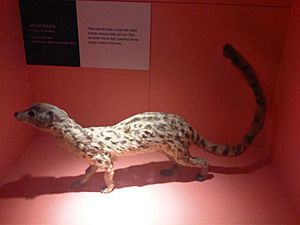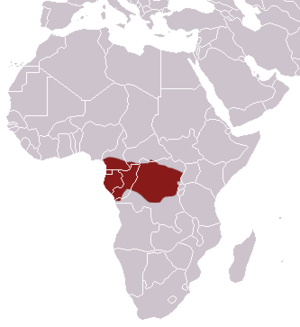Central African oyan facts for kids
Quick facts for kids Central African oyan |
|
|---|---|
 |
|
| Conservation status | |
| Scientific classification | |
 |
|
| Central African oyan range |
The Central African oyan (Poiana richardsonii) is a small, cat-like animal. It is also known as the Central African linsang. This animal lives in the forests of Central Africa. It is a shy creature that spends most of its life high up in the trees.
Contents
What it Looks Like
The Central African oyan has a long, slender body. Its head is narrow with a pointed nose. Its fur is usually yellowish or reddish-brown. It has darker spots on its back and sides. Its throat and belly are lighter in color and do not have spots.
Its tail is long, about the same length as its body. It has 9 to 14 dark rings on its tail. The oyan's body is about 33 to 43 centimeters (13 to 17 inches) long. Its legs are short, and the bottoms of its feet are hairy. Female oyans are a bit smaller than males.
Where it Lives
The Central African oyan lives only in Central Africa. You can find it in countries like Cameroon, Equatorial Guinea, Gabon, and the Democratic Republic of the Congo. It prefers to live in lowland and mountain tropical rainforests.
Sometimes, scientists use special cameras to study animals. In Gabon, a camera once recorded an oyan walking on the forest floor. This shows they sometimes come down from the trees.
How it Behaves
The Central African oyan mostly lives high up in the treetops. It is rare to see them on the ground. These animals are nocturnal, meaning they are active at night.
They hunt for their food in the dark. They eat small rodents and birds. They also enjoy eating insects. Not much is known about how they have their babies.
Naming the Oyan
The Central African oyan was first described in 1842. It was named Genetta richardsonii to honor a naturalist named John Richardson. Later, in 1864, another scientist moved it to a new group called Poiana.
There are two main types, or subspecies, of the Central African oyan:
- Poiana richardsonii richardsonii
- Poiana richardsonii ochracea
What Threatens It
The Central African oyan might be in danger because of deforestation. This is when forests are cut down. It might also be threatened by bushmeat hunting, which is when people hunt wild animals for food.
See also
 In Spanish: Linsang africano para niños
In Spanish: Linsang africano para niños


